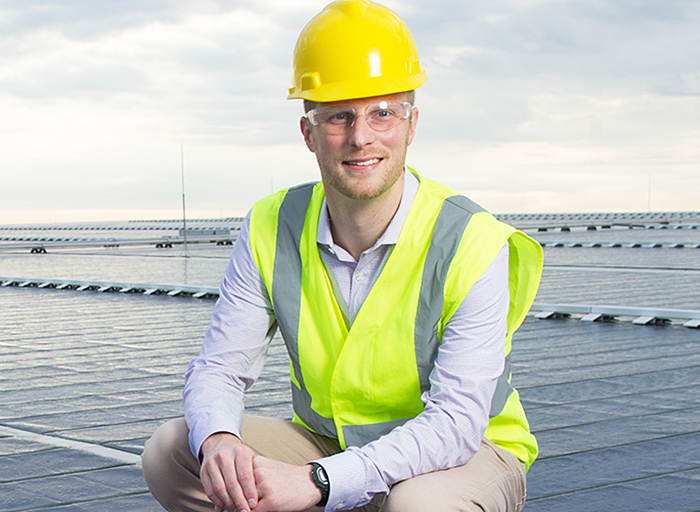Energy for a brighter future

Chris Roe works with utilities across the country to find the best sources of electricity for Boeing’s offices and factories. The power mix includes renewable energy, such as the 10 acres (4.05 hectares) of solar panels on the roof of the final assembly building at Boeing South Carolina. (Boeing photo)
Few people know as much about electricity use in Boeing’s buildings as Chris Roe. Flip on a light switch in any facility in any state and he likely can tell you where that power comes from, how it was generated and how much it cost.
“I help Boeing purchase electricity to power our buildings across the country. It can be an amazing puzzle of generation sources, utility coordination and government regulations,” said Roe, an engineer and energy resource leader.
Roe also helps coordinate Boeing’s energy conservation program, which has produced major progress in improving the efficiency of the company’s internal operations and expanded the use of renewable and low-carbon energy sources at a growing number of sites.
Boeing this year earned the 2014 ENERGY STAR Partner of the Year Sustained Excellence award from the EPA for leadership in energy conservation. Boeing has won the ENERGY STAR award every year since 2011.
On the energy supply side, Roe navigates a complex and varied energy marketplace where unique regulations govern how customers buy power and select the sources of energy they want.
The process of buying power starts at an individual Boeing site. “I work with Boeing facilities to better understand the site’s business plan and forecasted energy need to support their particular operations,” Roe said. “We get a good energy forecast developed and start competitive procurements with different companies.”
In many locations, however, the energy market is not competitive but regulated, including utilities’ rates. “For some facilities, we can buy power only from the local utility. In areas that allow direct access to a competitive market, we have more flexibility in how we source our energy supply,” Roe said.
Historically, Boeing’s main criteria in sourcing power have been reliability and predictable pricing, not how it’s generated, Roe said.
Roe said Boeing is testing innovative strategies to better manage energy demand, too. “We’re looking at creative approaches to buildings, such as leveraging ‘big data,’ or real-time monitoring of all systems that use energy to help reduce demand.”
All new building construction or major remodeling is done to LEED Silver rating or higher, Roe said. Super-efficient LED lighting is replacing conventional lighting technology in factories and office buildings across the company.
Roe said improvements in energy efficiency can be found at almost every Boeing site. Even with robust business growth, from 2007 to 2012 the company reduced energy consumption by 3 percent, the equivalent of enough energy to power 44,000 U.S. homes for a year.
But do big energy-saving projects really help change employees’ behavior? Roe thinks “absolutely.” “Seeing tangible improvements in the company’s environmental performance can inspire people to be more energy efficient and sustainable in their daily lives at work and at home,” he said.
“We’ve made good progress. If we can continue building momentum with Boeing’s 170,000 employees, I think we’ll be amazed at what small, everyday improvements can mean for our planet.”

